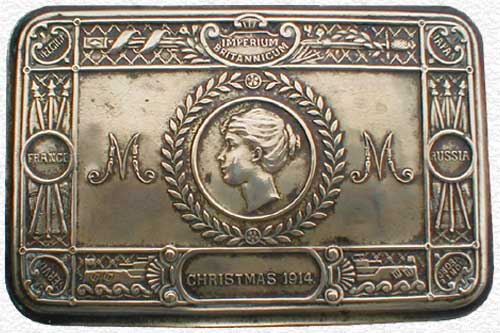Christmastime is upon us, though we have not had any snow in the last month here in Connecticut and the weather is confusingly blithe. In spite of the friendly temperatures and distinct lack of a need for boots/gloves/hat/scarf at all times, I have begun my Christmas shopping and am doing a bit of holiday crafting each evening. It seems to be time to bring the Yuletide to "Ghosts of 1914," so I thought I would write a bit about the wartime gift meant for everyone in the British Army: The Princess Mary Christmas Gift Box.
 |
| The Princess Mary Christmas Gift Box, Village of Kinnethmont, Scotland, website. |
James M. Grant's Village of Kinnethmont website has a lovely overview of the Christmas Gift Box's history and contents. According to Grant and other sources, Princess Mary, the daughter of King George V, established a Christmas Gift Fund for soldiers and sailors in November, 1914, to collect contributions towards a present for those on the front. Donations were plentiful, and it was decided that the best present for each soldier or sailor would be a metal box with thoughtful treats and other items. So thoughtful was the gift, in fact, that there was a version for smokers and for non-smokers!
 |
| Christmas Box and contents for smokers, © IWM, EPH 1992. |
 |
| Writing Stationery from a non-smoker's Christmas Box, ©IWM, EPH 2073. |
Beyond the differences for smokers and non-smokers, the boxes contained different assortments of items, depending on their recipients. Mr. Dick Elliot, of cigarhistory.info writes about the Gift Box that:
Officers and men on active service afloat or at the front received a box containing a combination of pipe, lighter, 1 oz of tobacco and 20 cigarettes in distinctive yellow monogrammed wrappers. Non-smokers and boys received a sterling silver bullet pencil in a .303 cartridge and a pack of sweets instead. Indian troops often got sweets and spices. Nurses were treated to chocolate. Contrary to opinion, they did not contain cigars. Many of these items were distributed separately from the tins themselves, as once the issue of tobacco and cigarettes was placed in the tin there was little room for much else apart from the greeting card.
--Dick Elliot, "The Princess Mary Tin"
In addition to the soldiers and nurses who received the boxes, the families of those who had been killed prior to Christmas, 1914, were also entitled to a tin. Though not every soldier received a box that year, due to the hazards and complications of delivery during combat, it is a testament to the tins' wide distribution and their sentimental value that the IWM features several (kept by veterans and/or their families and donated to the museum) in their permanent WWI galleries, as I observed when there in June, 2010. The museum's "Women, War, and Society" database also includes many documents relevant to the history of Princess Mary's Fund and the Christmas tins.
The BBC Schools WWI website has an intriguing little interactive feature that includes a Christmas Gift Box among other artifacts that a typical British soldier would have amassed during his service.
Well, we'll close the lid on this little Christmas Box post for now, but we will continue the holiday-themed entries at "Ghosts of 1914." In light of the time of year and perhaps in honor of the ghosts of 1914-1918, I hope that you will consider a holiday contribution of some kind for veterans or soldiers serving today. Until next time, may your days be merry and bright.
© Fiona Robinson
No comments:
Post a Comment